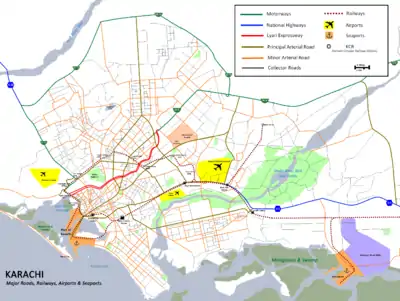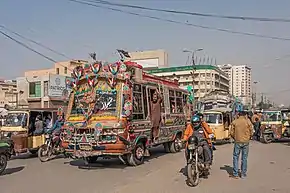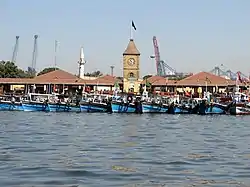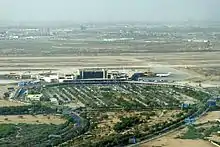Transport in Karachi
The city of Karachi is a major transport hub of Pakistan. The Karachi port and airport are major gateways to Pakistan. The Karachi Railway stations transports the major part of Pakistan's trade with other countries.




Local transport
Minibuses, coaches and large buses (all with a separate compartment for women) typically provide the cheapest way to commute across the city. Rickshaws, Qingqi [1] and taxis cater to the travelling needs of upper middle class, while radio cabs or white cabs are frequently used by upper class travelers. This makes it possible for people without their own vehicles to access remote areas of the city.
Auto rickshaws

A motorized three-wheeler (pictured) that seats two passengers generally used for short distances. In addition there are around 50,000 six-seater rickshaws operating in the city. In 2019, a distance of six kilometers should not cost more than Rs10 according to the government’s tariff.[2]
Taxi cabs
Karachi has three types of taxis: Yellow Taxi, Black Cabs and the Taxi Cab companies. These cab companies are:
Metro Cabs (Corolla),[3] Radio Cabs,[4] White Cabs (Corolla),[3] Red Top (Liana), Pearl Cab (Corolla), Star Cab (Corolla), Pak Cab. These cabs are mostly used in airports.
Buses

The people of Karachi use minibuses, coaches, and large buses.[5] They are often cramped and filled to the brim. They are often operated by reckless drivers who do not follow the rules of the road, endangering many. In 2008, the city mayor ordered fifty CNG buses for usage instead of the old minibuses with no fixed routes.
Cars
Many wealthier Karachiites own private cars, Suzuki's Mehran is the most commonly used car followed by Toyota's Corolla. Cars like the Vitz and Swift have also started being used since 2013, and Prados and Jeeps are now common as well.
Goods transport
Trucks, containers and small suzuki are used to transport goods in Pakistan. There are many goods transporters and forwarders who transport locally by road in all areas of Karachi [6]
Rail transport
Railways
Karachi is linked by rail to the rest of the country by the Pakistan Railways. The Karachi City Station and Karachi Cantonment Railway Station are the city's two major railway stations. The railway system handles a large amount of freight to and from the Karachi port apart from providing passenger services to people travelling up country.
Rapid transit
Plans are underway to extend the intra-city railway system to play a part in the city's mass transit through Karachi Circular Railway system. Currently, primarily motorists and minibuses handle commuter traffic, but there are plans to construct a two Metro train systems in the city called Karachi Metrobus to decongest the roads and provide quick service to commuters. Five bus rapid transit systems called Karachi MetroBus are also planned.
Tramways
A number of tramway routes were operated by the Mohamedali Tramways Company in Karachi before 1975.[7][8][9]
Streets, motorways and highways
National Highway (N-5)
The N-5 or National Highway 5 is the longest national highway in Pakistan and serves as an important north–south road artery which extends from Karachi in Sindh province to Torkham in the Federally Administered Tribal Areas (FATA)
Motorway M-9
The M9 Motorway, also called Super Highway begins north of Karachi at the end of Mohammad Ali Jinnah Road, near junction of Karachi Northern Bypass (also known as M10). It is connected with the Karachi Northern Bypass with a trumpet interchange. Then it continues out of the city. From there it continues on a northeast track and forms a junction with the N5 via a link road. Once out of Karachi it enters the desert of Thar. The motorway ends outside of Hyderabad, in the suburban town of Kotri with a cloverleaf interchange. From there it merges onto the N5.
RCD Highway (N-25)
The N-25 National Highway or RCD Highway connects Karachi with Hub, an industrial city in Balochistan and Quetta, the capital of Balochistan and onwards to Afghanistan, Iran and Turkey. It also connects Karachi with Makran Coastal Highway (N-10) and Motorway M-7. The RCD Highway was constructed under a treaty between Pakistan, Iran and Turkey to promote economic cooperation.
Karachi Northern Bypass (M-10)
Karachi Northern Bypass (M10) begins north of Karachi at the end of Mohammad Ali Jinnah Road, near the junction of the M9. It then continues north for a few kilometers before turning west, where it forms an interchange with the N25. After this interchange it eventually turns south back towards Karachi and merges onto the KPT Flyover at Karachi Port.
Lyari Expressway
Lyari Expressway is a highway along the Lyari River in Karachi, Sindh, Pakistan connecting the Port of Karachi with M9 Motorway. Lyari Expressway's North bound section is recently opened for traffic while the South bound corridor was completed and inaugurated for traffic in 2008.[10] This toll highway is designed to relieve congestion in the city of Karachi. It is a 16.5 km expressway that consist of four lanes on both sides, with two interchanges, five overpasses and five underpasses. Moreover, two lanes each are constructed on banks of the Lyari River. The expressway has toll plazas at four locations.[11]
Malir Expressway
Malir Expressway is currently a 38 km proposed expressway starting from Hino-Chowk and ending near Kathore on the Superhighway (M-9) along the Malir River. The expressway would serve as the Southern alternative route for carrying traffic of the port and industrial areas to main highways.
Hawkes Bay Expressway
The Hawkes Bay Expressway is a proposed expressway along Mauripur Road.[12]
Sindh Coastal Highway
The Sindh Coastal Highway connects Karachi with coastal cities of Sindh. It starts from N5 between Dhabeji and Gharo and ends near Keti Bunder.
National Highway 110 (N-110)
The National Highway 110 or the N-110 connects Gharo to the town of Keti Bunder in Thatta District in Sindh province of Pakistan. Its total length is 90 km.
Waterways

Two ferries operate between Kemari and Manora Island named after Arfa Karim and Afza Altaf daily.[13] Besides these, hundreds of boats operate between Kemari and Manora daily.
Karachi-Mumbai Ferry Service operated until 1965. The ferry service played an important role of transporting Muslim refugees from India to Pakistan while bringing Hindu and Sikh refugees to India.[14]
Pipelines
White Oil Pipeline
The White Oil Pipeline (White Oil Pipeline Project (WOP)) carries imported oil from Port Qasim to Pak-Arab Refinery Limited (PARCO) at Mehmood Kot, Muzaffargarh, Punjab[15]
Sui Gas Pipeline
The Sui Gas Pipeline carries natural gas from Sui gas fields in Sui, Balochistan to Karachi, Sindh.
Ports and harbours
The largest shipping ports in Pakistan are the Port of Karachi and the nearby Port Qasim. These seaports have modern facilities and not only handle trade for Pakistan, but also serve as ports for Afghanistan and the land-locked Central Asian countries. Plans have been announced for new passenger facilities at the Port of Karachi.[16]
Port of Karachi
The Port of Karachi is Pakistan's largest and busiest seaport, handling about 60% of the nation's cargo (25 million tons per annum). The port is located between the towns of Kiamari and Saddar, close to the heart of old Karachi, the main business district, and several industrial areas. The geographic position of Karachi places the port close to major shipping routes such as the Strait of Hormuz. The administration of the port is carried out by the Karachi Port Trust which was established in the nineteenth century.
Port Qasim
The Port Muhammad Bin Qasim is a port in Karachi, Sindh, Pakistan on the coastline of the Arabian Sea. It was constructed in the late 1970s to relieve congestion at Karachi Port. The port was developed close to the Pakistan Steel Mills complex near the Indus River delta. Port Qasim's residential area is a neighborhood of Bin Qasim Town of Karachi.
Air transport

The Jinnah International Airport of Karachi is the largest and busiest airport of the country. It handles 10 million passengers a year. The airport also receives the largest number of foreign airlines, a total of 27 airlines fly to Jinnah International predominantly from the Middle East and South East Asia. All of Pakistan's airlines use Karachi as their primary hub including Pakistan International Airlines and airblue.
The city's old airport terminals are now used for Hajj flights, cargo facilities, and ceremonial visits from heads of state. U.S. Coalition forces used the old terminals for their logistic supply operations as well. The city also has two other airstrips used primarily by the armed forces.
See also
- Transport in Pakistan
- Jinnah International Airport
- Auto rickshaw
- Pakistan Civil Aviation Authority
- Makran Coastal Highway
- Port of Karachi
- Port Qasim
- Karachi Cantonment railway station
- National Highway Authority
- Lyari Expressway
- M9 motorway (Pakistan)
- Karachi Northern Bypass (M10 motorway)
- Karachi Transport Ittehad
- Ministry of Maritime Affairs (Pakistan)
- List of expressways of Pakistan
References
- The News March 21, 2020
- Samaa.tv January 9, 2019
- The News June 25, 2019
- The News February 15, 2019
- Tribune December 31, 2019
- PLDB. "All Pakistan Goods Transport". Appxone. Retrieved 3 November 2014.
- "History of Karachi- Showing trams". Retrieved 2009-10-29.
- "History of Karachi". Retrieved 2009-10-29.
- Jang 4 April 2010
- http://pakistaniat.com/2008/02/11/lyari-expressway-south-bound-inaugurated/
- "Lyari Expressway Plan Reviewed" 24 April 2004, Dawn
- "Proposal for Karachi's Hawkesbay Expressway sent to Chinese govt" 16 August 2017, Express Tribune
- The News International - Kemari--Manora ferry service sets sail
- Mumbai-Karachi: An ancient link
- Pak-Arab Refinery's oil pipeline operations
- "Projects". Karachi Port Trust. Archived from the original on 2011-08-25. Retrieved 2007-11-19.